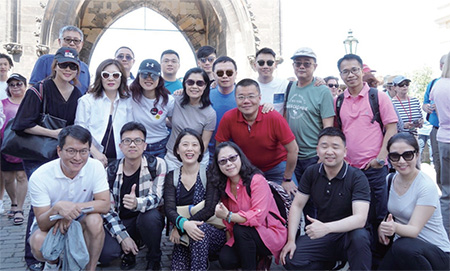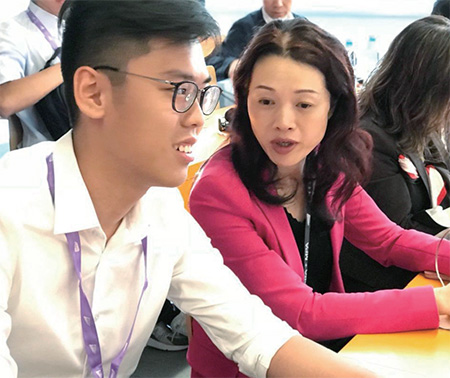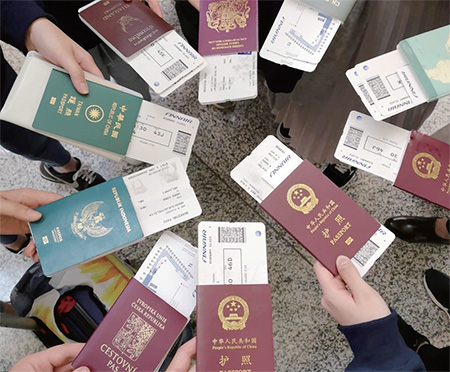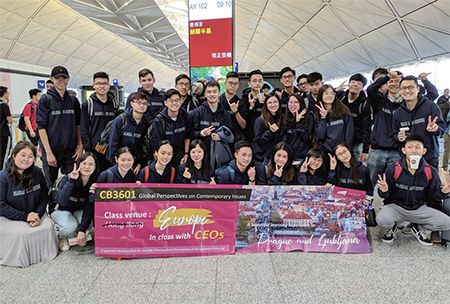Isabella Sun is Chief Student Learning Manager of the EMBA (Chinese) programme. She recently accompanied the EMBA+MPA programme on a visit to the Czech Republic and Slovenia. This is her account of the trip.
EMBA+MPA students in Prague
The College's undergraduate
course Global Perspectives
on Contemporary Issues
and EMBA+MPA programme went
truely global in early June, moving
their classrooms to Eastern Europe,
and finding plentiful evidence of
the Belt and Road Initiative (BRI) along the way. Led by Professor
Julie Li, Associate Provost, Codirectors
of the EMBA+MPA
programme Dr Gang Hao and
Professor Wayne Yu, and Dr Chakfu
Lam, BBA Global Business (GBUS)
Programme Leader, 27 GBUS yearone
students joined 29 students of the EMBA+MPA programme for
the 8-day study tour. Destinations
were Prague, capital of the Czech
Republic and Ljubljana, capital of
Slovenia.
The two groups of students participated in an array of learning activities including lectures, keynote addresses, company visits and networking events. This offered novel opportunities for interactive learning across the generations as the BBA students were able to connect with leading China business practitioners and others in the EMBA+MPA programme.
Dr Chak-fu Lam said, "One of the most memorable experiences was a networking dinner. BBA and EMBA+MPA students sat together and, at first, it was a challenge for students to mingle as they were still new to each other. But after a while, students got to relax a bit and talk to each other. They shared ideas, exchanged phone numbers, and most importantly, built connections. I think a few internships for first-year students were offered on the spot!"
Wai-shing Heung from the BBA with Lu Liu from the EMPA+MPA programme
The first stop was VŠE, The University of Economics, Prague, located in the centre of the old city. Founded in 1953, this is the largest institution of higher learning in the fields of economics, business, and information sciences in the Czech Republic. Numerous Czech political and business leaders have emerged from here, including the current Czech President Miloš Zeman.
On the first day of study, Mr Jan Brazda, CEE (Central and Eastern Europe) Advisory Partner, PwC, gave a keynote speech on Public Private Partnership (PPP) Projects in the Czech Republic and CEE. He explained that PPP is a contractual arrangement between public authority and private sector which results in greater private participation in the project, including value engineering and impacts on public finances spread over time.
At the airport – Ready to go!
"According to China International Contractors Association (CHINCA)'s analysis, from a regional perspective, CEE countries are ranked second place in Belt and Road regions. The future BRI national infrastructure development potential is huge and will remain on the rise. Among them, the ASEAN and CEE countries have the strongest market demand." It is expected that China will continue to deepen its investment in the infrastructure market in Central and Eastern Europe, providing further financing options to strengthen logistics connectivity throughout Eurasia and will continue to focus on investments such as transportation and oil and gas pipelines enhancing cross-border flows in related industries.
In Central and Eastern Europe, the funding gap for infrastructure construction is expected to reach 615 billion euros by 2025, and this situation will be significantly improved due to the involvement of PPP projects.
BBA Global Business students fly to Europe as part of the Global Perspectives on Contemporary Issues course
In the afternoon, Ambassador Jianmin Zhang of the Chinese Embassy in the Czech Republic came to class, revealing that 2019 is the 70th anniversary of the establishment of diplomatic relations between China and the Czech Republic. Back in 1949, the Czech Republic was the fourth country in the world to recognise the People's Republic of China. At that time, the young republic needed to develop and could not do without the strong support of the international community. The Czech Republic had a very good industrial base and gave China a lot of support – for example, helping to establish state-of-the-art farm in Cangzhou, Hebei.
Of course, visits to local business were an essential part of the trip. Czech glass crystal is famous throughout the world, and the Lasvit brand is one of the best, bringing a feast of visual light in glass crystal.
We also visited the headquarters of CITIC Europe, established in the Czech Republic as a platform for expansion in Europe. CITIC Europe plans to develop its business activities especially in manufacturing sector, travel industry and food industry, as well as other areas of business.
To Slovenia
After crossing the Charles Bridge in Prague, we arrived at the University of Slovenia, Ljubljana. Founded in 1919, this is the oldest and largest institution of higher learning in Slovenia and the alma mater of the first lady of the United States, Melania Trump.
Our first class, Slovenian Economy – From Yugoslavia to the European Union, was presented by Professor Mojmir Mrak. He explained that Slovenia's GDP per capita is now about 20,000 euros, equivalent to 80% of the EU's national average, but that the situation had been very different when Slovenia was founded in 1991. After gaining independence from Yugoslavia, Slovenia faced hyperinflation. The country did not even have time to design and print banknotes. For half a year, everyone used the vouchers of the Ministry of Finance.
To steady the economic situation, a currency was introduced through a managed floating exchange rate system. Deflationary monetary and fiscal policies were followed to reduce inflation, trade was liberalised to strengthen relations with the West, and structural reforms were brought into focus to stabilise the banking industry. In the end the problem of the external debt was solved. Throughout, people had hard currency in their hands and did not need to use local currency to buy things. This greatly suppressed inflation and eased panic. There was recovery and positive growth by 1993, and since then Slovenia's integration into Europe has been cemented by joining the EU in 2004, and adopting the Euro in 2007.
On the second day, Mr Danilo Türk, former President of Slovenia and former Assistant Secretary-General of the United Nations, arrived in the classroom. During his one-hour speech, he mentioned a series of hot issues such as the relationship between Central and Eastern Europe and the Belt and Road, and the Sino-US trade war. The Three Seas Initiative summit had recently been held in Slovenia – representing countries around the Baltic, Black and Adriatic seas. One of the main goals was to set up a fund to finance infrastructure projects. China's BRI is very relevant and many of the countries in the Three Seas Initiative are also along the Belt and Road which is having a great impact in Europe.
Mr Türk however foresaw some problems in the cooperation between China and Europe because of the complexity of the EU system. The main challenges are coordinating the economic development needs of the EU system and China, the relationship with the United States related to trade wars, and intellectual property rights. Europe also has very high environmental standards. All in all, it will be easier to invest in manufacturing industry than infrastructure. In sum Eastern Europe needs a large-scale cooperation framework system, and organisational relationships are very important for future development.
Last call was a company visit to a Slovenian Unicorn. Outfit7 is responsible for the world-renowned mobile pet application Talking Tom Cat. The app launched in July 2010, and after several successful years, was acquired by United Luck Group Holdings Limited for 1 billion US dollars in 2017. As of February 2019, Outfit7 apps have achieved more than 9 billion downloads. How did Slovenia produce such a unicorn in a small country with a population of only 2 million? The case study was divided into three parts: human resource management and startup culture; entrepreneurial innovation leadership expansion; and the growth of a unicorn – sustainable development and innovation.
Post-acquisition, the company faces various challenges including how to further expand, changes in its corporate culture, and how to achieve a reasonable return on investment while retaining the core of the company's success.
This was the first time that EMBA students shared the classroom with undergraduate students. We saw energy and hope in this next generation and wish all of them a great future!
A big thank you
Lastly, a big thank you to Dr Jennifer Cheung for her generous donation which made this trip possible for the GBUS students.
Isabella Sun
Chief Student Learning Manager
EMBA (Chinese) Programme





